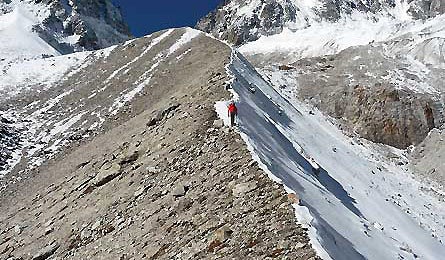Peakbagger Skills

'Mark Jenkins in Tibet'
ACCLIMATE ABROAD Maximize your summit potential with these tips for arriving rested and ready.
Avoid Jet Lag
>> Prep your sleep
Get eight to nine hours of shut-eye each night for a week before your departure date. If possible, adjust your sleep schedule pretrip by going to bed and waking up several hours earlier than normal if you’re flying east, or several hours later if you’re flying west.
>> Time it right
Choose flights with afternoon arrivals. Stay awake until it’s your normal bedtime in the local time zone (where you’re headed), and set an alarm so that you wake at a reasonable morning hour; limit sleeping time to eight hours.
>> Drink up
You lose 250 ml of water per day through normal breathing and even more when the air is dry (most overseas flights dehumidify cabin air). Slow dehydration by breathing through your nose and drinking lots of water. Aim to consume two liters on flights longer than five hours, always accept the flight attendants’ refill offers, and avoid alcohol.
>> Work out
Avoid heavy sweat sessions immediately before your trip. But upon arrival, take a brisk run, bike ride, or hike. The boost in circulation and the sun exposure will energize you, and the workout will help you feel more tired when your appointed bedtime arrives.
Adjust to Altitude
>> Ascend slowly
You’ll need about 10 days to become 85-percent adjusted to reduced oxygen at elevations above 8,000 feet. That’s a long time for most schedules, but you can minimize risk by moderating your ascending pace. Above 10,000 feet, limit increases in your sleeping altitude to 2,000 feet per night and be alert for signs of altitude sickness (headache, nausea, dizziness) while making daytrips to higher elevations.
>> Consider taking Diamox
For quick trips where your objective is above 10,000 feet, talk to your doctor about a preemptive prescription of acetazolamide (aka Diamox). The drug increases your blood’s oxygen-carrying capacity and allows you to adjust more quickly to low oxygen levels at high altitudes.
Get Foreign Beta
>> Study maps
Access high-resolution topos for just about any peak through online retailers like Omnimap.com.
>> Learn from the past
The American Alpine Club houses extensive expedition-report archives. A $75 membership provides access, plus basic rescue insurance.
>> Get first-person accounts
Quality mountaineering shops are often connected to well-traveled climbers. Ask retailers for help finding others who’ve been to or near your target.
Transport Your Gear Safely
>> Protect against punctures
Prevent sharp points from poking holes in your pack by using tip covers. Pack a file and refresh spikes anytime; learn how at backpacker.com/sharpencrampons.
>> Guard electronics
Pack as many of your expensive gadgets as possible in your carry-on. If you must check some, pack them in a clear, hard-sided container (inside your duffel), and lock your luggage with a TSA-approved lock.
>> Leave banned gear home
Bear spray, torch lighters, and all types of cooking fuel are prohibited on flights.